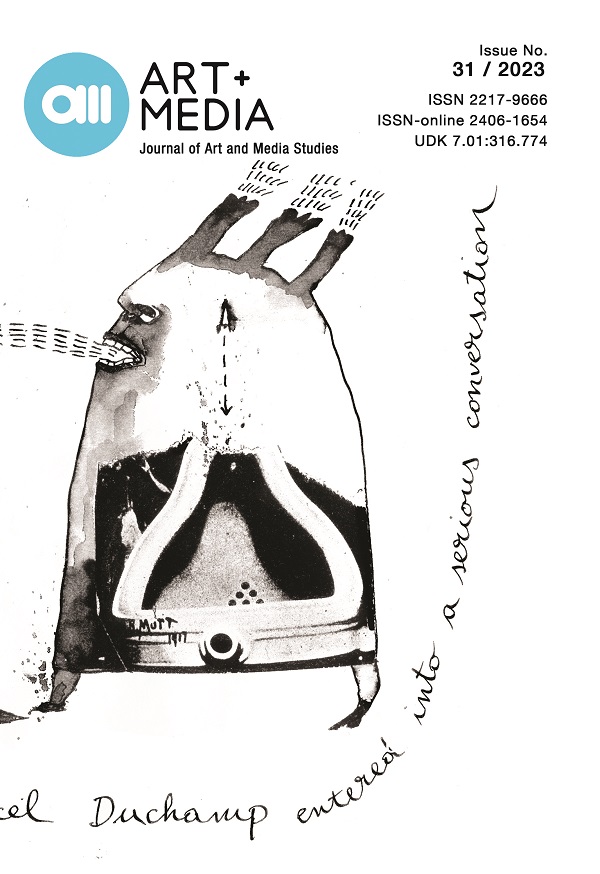Literary Works and the Metaphysics of Influence
DOI:
https://doi.org/10.25038/am.v0i29.571Abstract
When interpreting literary works, interpreters almost always rely on connections between the literary works and other aspects of our world – e.g., historical time periods, cultures, other artworks, artistic movements, and so on. But how can we explain both the nature and role of these connections? I argue that this can be fruitfully explained with reference to relations that exist between literary works and other aspects of human culture, which is a class of relations that I call ‘interpretation-relevant relations.’ I also argue that an important component of these relations is a mind-independent connection of influence between the relata. Finally, I argue that these interpretation-relevant relations (with the component of influence) can be taken to be real, mind-independent elements of the world, if we recognize that literary works are public artifacts and so are part of the fabric of human culture, which depends on human minds for its existence and persistence but not for its ontological nature. All of this can hold even if interpretations are the products of individual minds interacting intentionally with literary works.
References
Currie, Gregory. Narratives and Narrators: A Philosophy of Stories. New York: Oxford University Press, 2010. DOI: https://doi.org/10.1093/acprof:oso/9780199282609.001.0001
Lamarque, Peter. The Philosophy of Literature. Malden, Mass.: Wiley-Blackwell, 2009.
Lavoie, Chantel. “Rebelling Against Prophecy in ‘Harry Potter’ and ‘The Underland Chronicles’.” The Lion and the Unicorn 38, 1 (2014): 45–65. https://doi.org/10.1353/uni.2014.0003 DOI: https://doi.org/10.1353/uni.2014.0003
Nardin, Jane. “‘The Turn of the Screw’: The Victorian Background.” Mosaic: An Interdisciplinary Critical Journal 12, 1 Literature and Ideas (Autumn 1978): 131–142.
Olsen, Stein Haugom. “Literary Aesthetics and Literary Practice.” In The End of Literary Theory, 1–19. New York: Cambridge University Press, 1987. DOI: https://doi.org/10.1017/CBO9780511983498.002
Olsen, Stein Haugom. “Defining a Literary Work.” In The End of Literary Theory, 73–87. New York: Cambridge University Press, 1987. DOI: https://doi.org/10.1017/CBO9780511983498.007
Rauwerda, Antje M. “Katniss, Military Bratness: Military Culture in Suzanne Collins’s Hunger Games Trilogy.” Children’s Literature 44 (2016): 172–191. https://doi.org/10.1353/chl.2016.0016 DOI: https://doi.org/10.1353/chl.2016.0016
Thomasson, Amie L. “Artifacts and Human Concepts.” In Creations of the Mind: Theories of Artifacts and their Representation, edited by Eric Margolis and Stephen Laurence, 52–73. New York: Oxford University Press, 2007.
Thomasson, Amie L. “Public Artifacts, Intentions, and Norms.” In Artefact Kinds: Ontology and the Human-Made World, edited by Maarten Franssen, Peter Kroes, Thomas A. C. Reydon, and Pieter E. Vermaas, 45–62. New York: Springer International Publishing, 2014. DOI: https://doi.org/10.1007/978-3-319-00801-1_4
Thomasson, Amie L. “The Ontology of Literary Works.” In The Routledge Companion to Philosophy of Literature, edited by Noel Carroll and John Gibson, 302–312. New York: Routledge, 2016. DOI: https://doi.org/10.4324/9781315708935-30
Downloads
Published
How to Cite
Issue
Section
License
Copyright (c) 2023 AM Journal of Art and Media Studies

This work is licensed under a Creative Commons Attribution 4.0 International License.
The content on this site is licensed under a Creative Commons Attribution 4.0 International License.
AM Journal of Art and Media Studies ISSN 2217-9666 - printed, ISSN 2406-1654 - online, UDK 7.01:316.774
Contact: amjournal@outlook.com
Publisher: Faculty of Media and Communications, Singidunum University, Belgrade, Serbia
Indexed in: ERIH PLUS, EBSCO, DOAJ, and in The List of Scientific Journals Categorization of Ministry of Education, Science and Technological Development of Republic of Serbia (M24 in 2021; M23 in 2023). Beginning with No. 12 2017, AM is indexed, abstracted and covered in Clarivate Analytics service ESCI.

